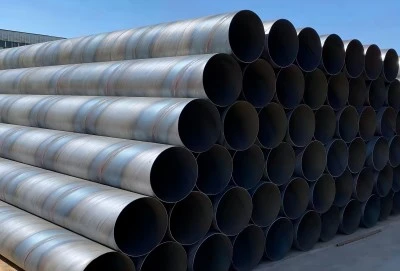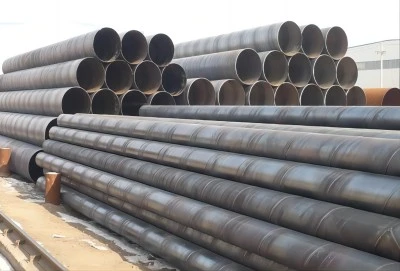In the world of industrial piping, two major types of pipes often come into focus: spiral welded pipes and seamless pipes. Both play crucial roles in various applications, but they differ significantly in their manufacturing processes, characteristics, and ideal use cases. This article delves into the key differences between these two pipe types, exploring their manufacturing methods, strength comparisons, and why spiral pipes are often preferred for large-diameter projects.
|
|
|
Manufacturing differences: spiral welding vs seamless process
The production methods for spiral welded pipes and seamless pipes are fundamentally different, each with its own unique advantages and challenges.
Spiral welded pipes, also known as spirally welded pipes or helical welded pipes, are manufactured using a continuous helical welding process. This process begins with a flat steel strip or plate, which is gradually formed into a cylindrical shape as it moves through the production line. As the steel is shaped, its edges are welded together in a spiral pattern, creating a continuous seam that runs along the length of the pipe. This method allows for the production of pipes with large diameters and varying wall thicknesses.
The spiral welding process offers several advantages:
- Ability to produce pipes with large diameters (up to 120 inches or more)
- Efficient use of raw materials, as pipes can be made from steel coils or plates
- Flexibility in adjusting pipe diameter and wall thickness
- Cost-effective for large-diameter pipes
On the other hand, seamless pipes are manufactured through a completely different process. The production of seamless pipes starts with a solid steel billet, which is heated to high temperatures and then pierced or drawn over a mandrel to create a hollow tube. This tube is then rolled and stretched to achieve the desired diameter and wall thickness. The result is a pipe without any welded seams along its length.
The seamless pipe manufacturing process has its own set of advantages:
- No welded seams, potentially reducing the risk of structural weaknesses
- Uniform wall thickness and roundness
- Generally higher pressure ratings compared to welded pipes of the same dimensions
- Ideal for applications requiring high precision and reliability
Understanding these manufacturing differences is crucial for engineers and project managers when selecting the appropriate pipe type for specific applications.
Strength, reliability, and pressure handling comparisons
When it comes to strength, reliability, and pressure handling capabilities, both spiral welded pipes and seamless pipes have their strengths and considerations.
Spiral welded pipes, despite having a continuous weld seam, can be engineered to withstand significant pressures and loads. The spiral welding process, when performed with precision and quality control, can create a strong and reliable seam. Modern welding technologies and inspection methods have greatly improved the quality and reliability of spiral pipes. These pipes can be designed to handle high internal pressures and external loads, making them suitable for a wide range of applications, including oil and gas transmission, water pipelines, and structural purposes.
Key strengths of spiral welded pipes include:
- Ability to handle high internal pressures when properly designed and manufactured
- Good resistance to external loads and environmental stresses
- Flexibility in design allows for optimized strength-to-weight ratios
- Cost-effective solution for large-diameter, high-pressure applications
Seamless pipes, by virtue of their manufacturing process, are often considered to have superior strength and reliability, especially in high-pressure and critical applications. The absence of a weld seam eliminates potential weak points along the pipe's length. This characteristic makes seamless pipes particularly suitable for applications where the highest levels of safety and reliability are required, such as in high-pressure boilers, hydraulic systems, and certain oil and gas applications.
Advantages of seamless pipes in terms of strength and reliability include:
- Higher pressure ratings compared to welded pipes of the same dimensions
- Uniform strength along the entire length of the pipe
- Reduced risk of failure due to weld defects
- Better performance in applications with cyclic loading or high-temperature variations
It's important to note that the actual strength and reliability of both pipe types depend on various factors, including the quality of materials used, manufacturing processes, and quality control measures. Modern spiral welded pipes, when produced to high standards, can often meet or exceed the performance requirements of many applications traditionally served by seamless pipes.
Why do spiral welded pipes dominate in large-diameter projects?
Spiral welded pipes have become the preferred choice for many large-diameter pipeline projects, particularly in sectors such as water transmission, oil and gas transportation, and large-scale industrial applications. Several factors contribute to the dominance of spirally welded pipes in these areas:
- Cost-effectiveness: For large-diameter pipes, the spiral welding process is generally more cost-effective than seamless pipe production. The ability to use steel coils or plates as raw material, combined with the efficient manufacturing process, results in lower production costs per unit length of pipe.
- Large diameter capability: Spiral welded pipes can be manufactured in diameters far exceeding those possible with seamless pipes. While seamless pipes are typically limited to diameters of about 24 inches, spiral pipes can be produced with diameters of 120 inches or more. This makes them ideal for high-volume fluid transportation projects.
- Flexibility in production: The spiral welding process allows for greater flexibility in adjusting pipe diameters and wall thicknesses. This adaptability is particularly valuable in large projects where varying specifications may be required along different sections of the pipeline.
- Length advantages: Spiral pipes can be produced in longer continuous lengths compared to seamless pipes. This reduces the number of field joints required during pipeline installation, potentially lowering installation costs and reducing the number of potential weak points in the system.
- Material efficiency: The spiral welding process allows for more efficient use of steel, with less waste compared to the seamless pipe production process. This not only reduces costs but also aligns with sustainability goals in large infrastructure projects.
- Improved welding technologies: Advancements in welding technologies and quality control processes have significantly improved the reliability and performance of spiral welded pipes. Modern spiral pipes can meet stringent industry standards and perform well in high-pressure and demanding environments.
- Customization options: Large-diameter spiral pipes can be customized with various coatings and linings to enhance corrosion resistance, reduce friction, or improve other performance characteristics. This versatility makes them suitable for a wide range of environmental conditions and fluid types.
These factors combine to make spiral welded pipes an attractive option for large-scale pipeline projects. Their ability to balance cost-effectiveness, large-diameter capabilities, and performance has led to their widespread adoption in major infrastructure developments worldwide.
For those involved in pipeline projects, especially large-scale ones, understanding the characteristics and benefits of spiral welded pipes is crucial. As one of China's leading ERW/LSAW steel pipe manufacturers since 2003, Longma Group specializes in the production of large-diameter, thick-walled, double-sided, sub-arc-seam welding steel pipes, including LSAW (Longitudinal Submerged Arc Welded) and ERW steel pipes. With an annual output exceeding 1,000,000 tons by the end of 2023, Longma Group has the expertise and capacity to meet diverse project needs. For more information or to discuss your specific pipe requirements, please don't hesitate to contact us at info@longma-group.com.














